January 15, 1943
(13th AF) A single B-17 attacks Ballale.
January 15, 1943
(13th AF) A single B-17 attacks Ballale.
 January 16, 1943
January 16, 1943
(13th AF) B-17s bomb Ballale. Aerial reconnaissance photograph from 22,500'.
January 18, 1943
(13th AF) B-17s, P-38s and P-40s bomb Ballale.
January 25, 1943
(13th AF) B-17s attack Ballale.
January 26, 1943
(13th AF) B-17s bomb Ballale escorted by P-39 pilot McCulla and P-39 pilot Fiedler.
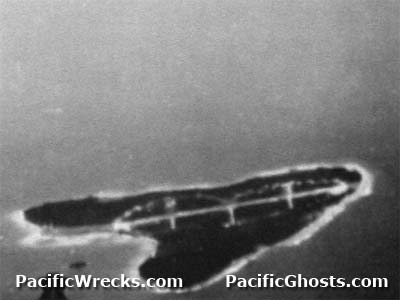 January 29, 1943
January 29, 1943
(USN) Photographic reconnaissance photo of Ballale.
February 1, 1943
(Japanese) The population on Ballale includes 1,200 (including 665 factory workers) Japanese Navy 8th Construction
Group, 1,560 Japanese Army soldiers and 300 Solomon Islanders working as laborers.
February 14, 1943
(USN, 13th AF) Zeros from Ballale take off to intercept nine PB4Ys and P-38s attacking shipping in the Buin-Shortland area. Lost in the area is P-38G pilot Rist (MIA). Americans lost a total of 10 planes: PB4Y-1 31948 and PB4Y-1 31970, P-38G piloted Finkenstein (MIA), P-38G piloted by White (MIA), P-38 piloted by 2nd Lt. Huey (MIA), P-38G piloted by John R. Mulvey Jr. (rescued), and P-38G piloted by Wellman H. Huey (POW) and F4U 02187 and F4U 02249 and F-5A Lightning 42-12678 (MIA).
February 15, 1943
(13th AF) B-24s, hindered by effective AA fire at Kahilli and Ballale,
2 B-24s are lost.
February 17, 1943
(13th AF) Single B-24s bomb Ballale.
February 19, 1943
(5th AF) B-17s bomb Ballale
(RAAF) Four PBYs took part in a raid on Ballale. Carried out what was one
of our most successful raids ('the night
Ballale was set on fire'). Some of the other Cats had already arrived and
started 'work' (times were usually staggered due to operational reasons)
and six big fires were already burning. We stayed over the target at 8000
ft for about an hour dropping two 500 lb, four 250 lb and twenty 20 lb and
some leaflets (which probably didn't hurt as much). We started one huge explosion,
four very large fires, and seven or eight small ones. There was intense heavy
ack-ack (and quite accurate), intense but inaccurate light ack-ack, and two
very well operated searchlights. We saw two of the Cats over the target.
We also copped some flak from the Buin anchorage when they felt we were trespassing
on their air space. I found it fascinating watching the tracer ack-ack coming
at us. Every shell seems to be coming straight at me and seemingly at the
last moment they zip to one side or the other.
February 20, 1943
(13th AF) B-17s and PBYs bomb Ballale.
(5th AF) B-17s bomb Ballale.
(Japanese) 6th Kure Toku [6th Kure Heavy Gunnery Group]) More than 7 planes including
B-17s, B-24s and PBYs strike Ballale from February 19, 1942 at 11:25pm until
February 20, 1943 until 2:23am. We
took
strong
bombing. By the Our Koukaku [cannon], B-24, one machine shot down. Ammunition expended: Koukaku cannons [Heavy AA]: 176 and High sky firing cannon [AA]: 140. No damage
does not occur in us.
Another account: Late at night,
some times of bombing was taken for three hours. An airport, entai-gou (Storage
place where it is reinforced )and a barracks were destroyed. The drum (600)
of
the aviation
fuel stored
around the barracks exploded. It couldn't extinguish the fire. As for us,
it was as much as possible to run away. Two fighters are went up up in flames, two machines damage. Wounded person is a small number. Death
in battle is zero. It was a miracle that there was no death.
The soldier watching it from Buin said "Ballale
burned out at last, too."
Another account no. 2: There was much night bombing. A
factory worker couldn't sleep, and grew weak. They had to sleep in the
air-raid
shelter. Sick persons
increased because the environment of the air-raid shelter was bad.
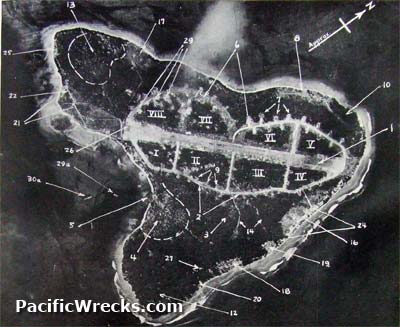 February 22, 1943
February 22, 1943
(Japan) Islanders assisting on the island were ordered to be sent home, all were evacuated by the end of March.
February 26, 1943
(13th AF) Photographic
reconnaissance over Ballale from 25,000'.
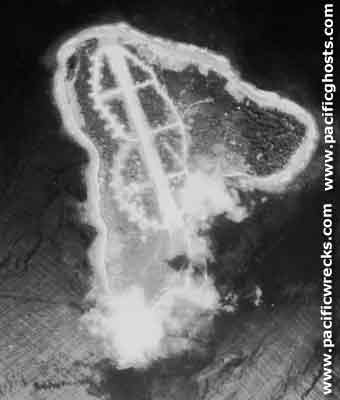 February 27, 1943
February 27, 1943
(13th AF) F-4 from the 6th PRG, 8th PRS makes a photographic
reconnaissance over
Ballale at 32,500'.
February 28, 1943
(13th AF) B-24s hit Ballale.
March 3, 1943
(USN) Nine PBY4 of VB-101 took off from Henderson Field at 1:30am to bomb Kahilli Airfield, Ballale Airfield and Vila Airfield. They proceeded through searchlights and AA fire to drop 500 lbs bombs from medium altitude.
March 4, 1943
(13th AF) B-24s hit Ballale Airfield.
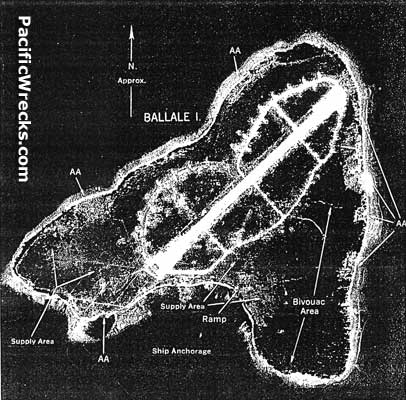 March 5, 1943
March 5, 1943
(USN) Seven PBY4 of VB-101 took off from Henderson Field at night. Only five hit the targets of Kahilli, Ballale, Vilu and Munda. Two aborted: one suffered mechanical problems, the other severe weather. Lost is PB4Y-1 31947 and PB4Y-1 31948 (MIA).
March 6, 1943
(13th AF) B-24s bomb Ballale.
March 9, 1943
(13th AF) Single B-24 bombs Ballale.
March 12, 1943
(13th AF) B-24 raid on Ballale.
May 12/13, 1943
(13th AF) During the night of May 12-13, B-24 on snooper missions bomb Ballale Airfield.
March 16, 1943
(13th AF) B-17s and B-24s on harassing raids bomb Ballale.
March 17, 1943
(13th AF) B-17s continue harassing raids on Ballale.
March 19, 1943
(13th AF) B-17's and B-24's on armed reconnaissance bomb
Ballale Airfield.
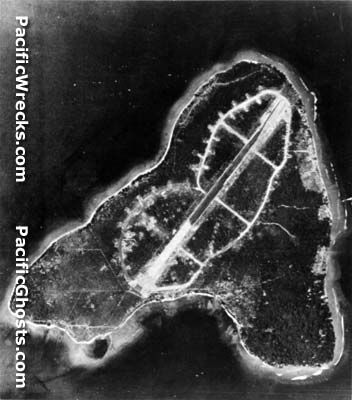
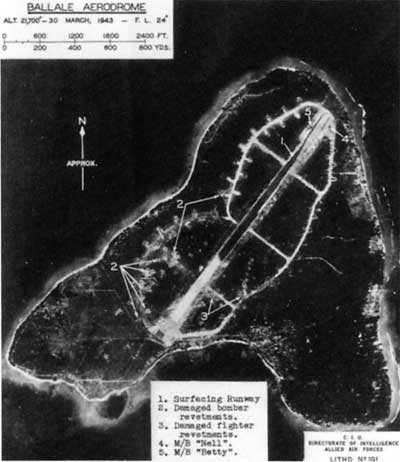 March 30, 1943
March 30, 1943
(13th AF) Aerial reconnaissance photo taken from 21 ,700'
The photo notes surfacing runway (repairs), damaged bomber revetments, damaged fighter revetments, medium bomber 'Nell', medium bomber 'Betty' on the apron on the northeastern end of the runway.
March 31, 1943
(IJN) Vice Admiral Jinichi Kusaka visits Ballale.
April 6, 1943
(IJN) Japanese carrier planes including A6M Zeros and D3A2 Vals arrive at Ballale ahead of Operation I-Go.
(13th AF) Allied intelligence spotted 95 aircraft at Ballale.
April 7, 1943 Operation I-GO
(IJN) On April 7, 1943 there was a major assembly of A6M Zeros at Ballale including Zeros from Junyō, Hiyo and Zuihō. Allied F-5 Lightings performing aerial photography spotted 64 aircraft (40' span, 30' length) that were fighters there that day in addition to dive bombers. The heavy concentration of fighters seen at Ballale on April 7, 1943 in the morning did not remain afterwards. By 5:15pm photographic reconnaissance showed only 25 fighters present (some may have been misidentified D3A Vals). Other sources indicate the heavy concentration of aircraft returned to Rabaul for raids against other targets in New Guinea during Operation I-Go. Thanks to Richard Dunn for this information.
April 11, 1943
(13th AF) B-17's bomb Ballale Airfield.
April 18, 1943
(IJN)Yamamoto Mission:
G4M1 Betty 2656 Tail 323 with passenger Admiral Isoroku Yamamoto plus G4M1 Betty Tail 326 with passenger Vice-Admiral
Matome Ugaki took off from Lakunai Airfield near Rabaul on a flight bound for Ballale Airfield but both bombers are shot down over southern Bougainville by intercepting P-38G Lightings "Operation Peacock".
April 27, 1943
(13th AF) B-24's hit Ballale.
May 6, 1943
(13th AF) B-24's carry out harassing strikes Ballale.
May 12, 1943
(13th AF) At night, two B-24s and 6 B-17s attack Ballale and Kahili in two separate waves.
May 13, 1943
(13th AF) 5 B-17's again hit Ballale Airfield
in the evening.
May 14, 1943
(13th AF) Single B-24 on snooper missions hit Ballale Airfield.
May 19 , 1943
(13th AF) During night of 19-20, four B-17s and two B-24s fly light harassing raids against Ballale and Kahili.
May 20-21, 1943
(13th AF) During the night of May 20-21, B-24's on snooper missions hit Ballale.
May 22-23, 1943
(13th AF) During the night of May 22-23 five B-24's hit Ballale.
June 8, 1943
(13th AF) B-24'a on armed reconnaissance bomb Ballale.
June 15, 1943
(13th AF) B-24's bomb Ballale Airfield.
June 18, 1943
(13th AF) 42nd BG B-25's hit Ballale.
June 24, 1943
(13th AF) Photo recon of Ballale showed 12 operative twin-engine bombers, 1 operative dive bomber, 5 operative VF ("These planes have been in the same position for approximately 2 months and may be inoperative, although there is no apparent damage"), and 4 inoperative VF.
(USN) At night, PB4Y's of VB-102 bomb Ballale dropping 20 x 120 lbs fragmentation cluster bombs, attacking singularly in staggered formation at an altitude of 11k, 14k 15,000'. Coming over Nusave, the first bomber was picked up by searchlight at inaccurate anti-aircraft fire, and dropped its bombs thinking that was the target. The other two found the target, circled and bombed the Island successfully.
June 25-26, 1943
(13th AF) During the night of June 25-26 a formation of B-24's bomb Ballale Airfield.
June 27, 1943
(13th AF) B-25's hit Ballale. Three PB4Y from VB-101 bomb Ballale from 10,000'.
June 30, 1943
(USN) Task Group 36.2 commanded by Rear Admiral A. S. Merrill bombards Ballale and mining operations in Shortland area. Including cruisers: USS Montpelier (CL-57), USS Cleveland (CL-55), USS Columbia (CL-56), USS Denver (CL-58) and destroyers: USS Philip (DD-498), USS Saufley (DD-465), USS Renshaw (DD-499) and USS Waller (DD-466). At 01:55 the force opened fire with main battery with full radar control on selected targets on Ballale at range of 16,400 yards. While a mine laying group of USS Pringle, USS Preble and USS Breese and USS Gamble laid mines 6000 yards ahead. No enemy gunfire was observed. The bombardment force sustains no casualties of material other than jamming of projectiles, and temporary failure of FH radar after opening fire.
July 4, 1943
(13th AF) B-24s over Buin fail to find shipping and
bomb Ballale instead.
July 5, 1943
(13th AF) B-24s hit Ballale.
July 6, 1943
(13th AF) B-17's and B-24's pound airfields. Lost is B-24D 42-40230 (MIA).
July 10, 1943
(13th AF) F-5A Lightning piloted by 1st Lt Lt. Eugene R. Brown took off on a photo reconnaissance mission over Kahili, Ballale and Shortland was intercepted by two Zeros from 582 Kokutai from Buin that shot out the left engine, but managed to dive to 500' and escape landing safely.
July 12, 1943
(13th AF) 17 B-24's bomb Ballale Airfield.
July 14, 1943
(13th AF) B-24's and B-17's bomb Ballale Airfield.
July 19, 1943
(13th AF) B-17's and B-25's bomb Ballale Airfield.
July 20, 1943
(13th AF) B-24s hit Ballale Airfield.
July 26, 1943
(13th AF) During night of July 26-27, six B-24s strike both Ballale and Kahili.
(USN) Two PB4Ys of VB-102 bomb Ballale under glare of searchlights and moderate but inaccurate A/A fire. One plane mistook Nusave for the target, and bombed it.
July 27, 1943
(13th AF) B-17's bomb Ballale Airfield.
July 30, 1943
(13th AF & RNZAF) 9 B-24's, with an escort of 16 P-38's and 16 P-40s from RNZAF No. 16 Squadron and
40+ US Navy F4U's to bomb Kahilli Airfield, but found it covered in clouds. Instead they hit Ballale Airfield. A6M Zeros
took off from Ballale before they reached the island, and released two
phosphorus bombs into the formation. Flak over target was severe, but the bombers dropped 22 tons of bombs. Zeros attacked when the formation left the target.
RNZAF made no claims and had two planes slightly damaged. Lost is F4U Corsair 02375 (MIA).
August 13, 1943
(13th AF) Eight B-24 bomb
Ballale Airfield at night, while 13 others bomb Kahili Airfield. Returning, one B-24 returning is hit by friendly anti-aircraft due to a Japanese air raid over Guadalcanal.
September 4, 1943
9 B-24's, 15 AAF fighters, and 20+ USN fighters hit Ballale Airfield.
September 14, 1943
(13th AF, USN) P-39's join
USN fighters and dive bombers in attack on Ballale Airfield. Lost are F6F Hellcat 8979 (rescued) and F6F Hellcat 09024 (MIA).
September 15, 1943
(13th AF) During the night, heavy
bombers bomb Ballale Airfield. During the day, Ballale Airfield is also hit by
USN dive bombers, supported by AAF, USN and US Marine Corps (USMC) fighters;
a bivouac area, revetments, supply dumps and gun positions are hit; the runway
appears badly damaged by the strikes. Lost are F6F Hellcat 25883 (MIA), F6F Hellcat 26009 (survived) and PV-1 Ventura 33214 (rescued).
September 16, 1943
(13th AF & USMC, USN, RNZAF) US Navy 24 SBD and 31
TBF strike Ballale Airfield escorted by 13 F6F from VF-38 and 11 F6F from VF-40
(first mission for Hellcats in theater) that took off from Fighter
One on Guadalcanal. plus f 13th Air Force fighters and RNZAF P-40s Kittyhawks. In addition, 23 F4U Corsairs from Marine Fighting Squadron 214 (VMF-214) "Black Sheep" led by Major Gregory "Pappy" Boyington took off from Banika Airfield at 1:00pm and rendezvous
over New Georgia with the formation. In total, more than 100 aircraft proceeded
to the target. Weather was partly cloudy, the attack began around 14:50.
There were a total of 71 escorts in the air. Over the target 40-50 Japanese
fighters including Zeros and Tonys and heavy anti-aircraft fire was encountered. The
204th Kokutai launched 26 Zeros. A large, sprawling dog fight ensued over
hundreds of miles. Greg Boyington scored victories over several Zeros, he
landed at Munda with only 10 gallons of gas, 30 rounds of ammo, and minor
damage from flying through the debris of a Zero that exploded in mid-air.
After refueling, he returning to Banika. VMF-214 were credited with
11 Zeros and 8 probable. Three F6Fs were lost: F6F
25839 (rescued) and F6F
Lt. Riley (recused) third MIA). One Hellcat was damaged and returning landed at Munda Airfield, then flown back
to Fighter One for a week of repairs. Two F4Us suffer minor damaged from
VMF-214. Lost is F4U
Corsair 17527 (MIA).
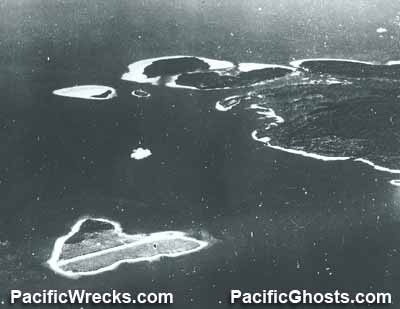 October 11, 1943
October 11, 1943
(USN) Aerial reconnaissance photo taken of Ballale and Shortland area.
October 16, 1943
(13th AF) 6 B-25's
hit the
airfield on Ballale.
October 17, 1943
Over the past two days (16-17) Japanese records indicate the loss of 15 Zeros
in the air, and deaths of 13 pilots (half a squadron). They claim 4 planes
shot down and two damaged, lost is F4U 17557 went MIA, and two
F4Us minor damaged.
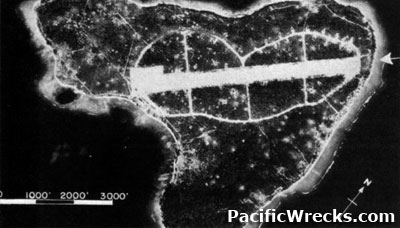 October
18, 1943
October
18, 1943
(13th AF) 24 SBDs and 12 TBFs escorted by 56 fighters hit Ballale. Eight minutes later, 28 B-24's
with cover of 50+ fighters including P-39s, 17 P-38s, F4U Corsairs of VMF-214 and VMF-221, hit Ballale from 18,000' Some of the 202 x 1,000lbs bombs hit the runway and dispersal areas. Lost is F4U 17557 (MIA). [Stills from newsreel]
Black Sheep One (2000) pages 265-266
"Boyington again led Corsairs towards Bougainville, this time as medium cover for an SBD strike on the notorious antiaircraft gun positions at Ballale. In a perfectly coordinated attack, TBFs simultaneously dive-bombed the runway, followed by B-24s that released their bomb loads from high overhead. Everything came together like clockwork. SBDs plastered the AA sites, the Avengers’ bombs crisscrossed the strip, then the ordnance from the heavies walked right down the runway centerline. Because the island was so small, the effect was like blasting an anchored carrier. Two clusters of Zeros were sighted, but Boyington held his Corsairs close to the SBDs and the Japanese never, challenged, probably because an overwhelming number of P-38s, P-39s, and New Zealand P-40s also maneuvered nearby.”
October 19, 1943
(USMC) A single F4U flown by George Ashmum from VMF-214 strafes Ballale's revetment
area for 10 seconds.
(USN) VB-140 PV-1 Ventura piloted by Willard attacks Ballale Airfield at low level, disabling planes in revetments and starting large fires.
October 28, 1943
(USN & 13th AF) 13th AF P-40's and P-39's join USN
fighters and dive bombers in attacks
on Ballale.
October 1943
(IJN) 23 photo sorties during October 1943 saw a maximum of 8 and an average of 4 fighters at Ballale, zero/zero dive bombers, and 1 twin engined bomber with an average of zero. Thanks to Richard Dunn for this information.
November 1, 1943
(USN) Task Force 38 (TF 38) under the command of Rear Admiral Frederick Sherman including USS Montpelier CL-57, USS Cleveland (CL-55), USS Denver (CL-58), USS Columbia (CL-56) and eight destroyers hit Japanese defenses on Ballale and Poporang.
(USN) VF-17 flights of eight F4Us patrol Empress Augusta Bay and strafe Ballale before returning to base at Ondonga. (1) The first , led by Lt. Lem Cooke strafes Ballale on their way home around 11:15am. (2) The second, led by Johnny Kleinman's flight strafes Ballale on their way home around 12:30. (3) The third, led by Halford's flight strafes Ballale on their way home around 18:00. Ballale responds with intense anti-aircraft fire, F4U piloted by John H. Keith is hit and begins to smoke heavily. He ditches his plane 5 miles SE of the island at 1810, and is observed to swim clear of the fighter. His wingman Ens Country Landreth (Landrew?) circles Keith until after sunset, when he loses sight of him in the darkness. Keith is not observed to deploy his life raft. A PT boat and a PBY search for Keith through the night and into the next day, with no success.
VF-17 The Jolly Rogers (1997) page 107:
"Dubbed 'Ballale Postgraduate School for Frustrated Anti-Aircraft gunners'.
On the way home from missions we would strafe Ballale. I was never convinced
that we did enough damage to warrant the risks, but I am certain our on going
efforts inflicted psychological damage. Still I am not sure that it was worth
the deaths sustained at the hands of their anti-aircraft gunners."
November 2, 1943
(USN) VF-17 F4U strafe Ballale on the way back from their mission. Tom Killefer
caught a 20mm shell in the cockpit, that blew up his oxygen bottle and
started a fire in the cockpit and wounded him. His F4U made it back to
base, the radio transmitter was damaged by the hit.
November 7, 1943
(USN) VF-17 F4Us strafe Ballale on the return from their mission to northern
Bougainville. Tom Killefer [plane damaged on November 2] is again damaged
in his right wing by 20mm shell.
November 9 , 1943
13th AF
P-39's join USN
aircraft hit Ballale Airfield.
November 10, 1943
(13th AF) B-25's
carry out strikes
on
Ballale Airfield.
November 14, 1943
(USN) Eight F4Us of VF-17 escort 54 SBDs and eight TBFs that proceeded through very
bad weather, to bomb anti-aircraft positions on the island. Anti-aircraft
fire was intense, no fighters were hit, and no bombers shot down.
November 16, 1943
(13th AF) P-40's and P-39's hit targets in on Ballale.
(RNZAF) 12 P-40s from 18 Squadron strafe anti-aircraft positions on Ballale.
F/O Lindsay David Hutton in P-40 NZ3166 was hit by fire from the east side
of the island. Streaming oil, he dived into the sea six miles south of Fauro, a parachute was observed to open but only just above the water, he
was seen to tread water, but then sank and disappeared, no further trace was
seen after 20 minutes of searching.
November 19, 1943
(13th AF) B-25's bomb Ballale Airfield.
November 26, 1943
(13th AF) One B-25 bombs the airfield on Ballale.
November 30, 1943
(13th AF and USN) fighters hit the SE coast of Ballale.
December 1, 1943
(13th AF and USN) USAAF fighters and USMC VMF-214 "Black Sheep"
lead by Pierre Carnnagey provide an eight plane F4U escort for bombers. After
discovering their primary target Chabai Airfield covered in clouds, the formation of
48 Navy SBD dive bombers, and 24 TBFs perform strikes on Ballale supply areas.
They met and observed no fighters at Ballale, only anti-aircraft fire. Two SBDs were lost SBD 11002 (rescued) and SBD 35976 (MIA).
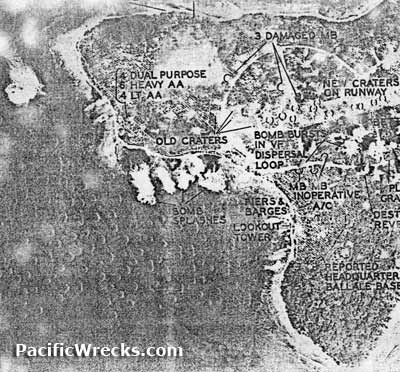
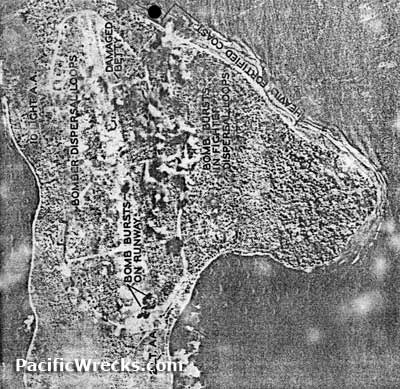 December 6, 1943
December 6, 1943
(USN) Bombing attack by VD-1. Photos issued by Interpron one (Navy Photo Intelligence Unit). The photograph from west side ("4 Dual Purpose") is the first VD-1 #41, and the photograph from east side ("Damaged Betty") is the second VD-1 #42.
December 13, 1943
(USMC) A pair of F4U Corsairs from VMF-223 strafe Ballale Island with unobserved results and encountered heavy anti-aircraft fire. Damaged by gunfire, F4U-1 Corsair 17452 pilot 1st Lt G. A. Davis ditched south of Alu Island and was rescued the next day by PBY Catalina.
December 17, 1943
(USN) Six TBF Avengers and six SBDs bomb Ballale Airfield. Plus another 2 TBFs and 11 SBDs from VC-40 fly the same mission.
References: NARA VC-40 War Diary November 1, 1943 to December 31, 1943 pages 21-22
(Page 21) "December 17, 1943. 7 VT and 6 VSB pilots engaged in attack on enemy, bombing..."
(Page 22) "December 17, 1943 [continued] ...Ballale Airfield. Pilots of other squadrons flew 2 TBFs and 11 SBDs of VC-40 on same mission, and 1 SBD of VC-40 in attack on enemy in Motupena Point area, Bougainville."
February 15, 1944
(USN) Ens George Keller, flying a single TBF flying from Guadalcanal
over flies Ballale area and is hit by heavy antiaircraft fire, damaging the
plane, and the supply of beer and liquor its carrying back to Piva strip
for men of VF-17. Hydraulic system was shot out, requiring him to fly with
the gear down by successfully landed at Torokina, but all the alcohol had been
destroyed in the bomb bay. Ballale was dubbed "Ballale Postgraduate School
for Frustrated Anti-Aircraft gunners".
March 1, 1944
(13th AF) P-38s hit Ballale.
May 26, 1944
(13th AF) 40+ P-39s and P-40s
hit barges NW of Ballale.
May 28, 1944
(13th AF) Fighter bombers
hit AA guns on Ballale.
October 1, 1944
(USN)
Two TDR-1 Assault Drones from Special Task Air Group One (STAG-1) target
anti-aircraft guns on Ballale. One drone hit a heavy anti-aircraft battery on western Ballale. The second drone hit the southwest end of the runway at Ballale within 100' or less of an area of heavy anti-aircraft and automatic AA guns.
October 19, 1944
(USN) Two TDR-1 Assault Drones from Special Task Air Group One (STAG-1) target
anti-aircraft guns on Ballale. The first,
one drone misses its target during its run; in the second, the drone drops part
of its ordnance [the two four-100-pound bomb clusters on the target before
it crashes.
References
Pacific Wrecks Chronology January, 15, 1943–October 19, 1944
The Siege of Rabaul (1996) by Henry Sakaida
VF-17 The Jolly Rogers (1997) by Tom Blackburn with Eric Hammel
The Black Sheep (2000) by Bruce Gamble
Black Sheep One (2001) by Bruce Gamble
Contribute Information
Do you have photos or additional information to add?